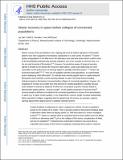| dc.contributor.author | Dai, Lei | |
| dc.contributor.author | Korolev, Kirill Sergeevich | |
| dc.contributor.author | Gore, Jeff | |
| dc.date.accessioned | 2017-04-14T19:41:55Z | |
| dc.date.available | 2017-04-14T19:41:55Z | |
| dc.date.issued | 2012-11 | |
| dc.date.submitted | 2013-04 | |
| dc.identifier.issn | 0028-0836 | |
| dc.identifier.issn | 1476-4687 | |
| dc.identifier.uri | http://hdl.handle.net/1721.1/108185 | |
| dc.description.abstract | Slower recovery from perturbations near a tipping point and its indirect signatures in fluctuation patterns have been suggested to foreshadow catastrophes in a wide variety of systems. Recent studies of populations in the field and in the laboratory have used time-series data to confirm some of the theoretically predicted early warning indicators, such as an increase in recovery time or in the size and timescale of fluctuations. However, the predictive power of temporal warning signals is limited by the demand for long-term observations. Large-scale spatial data are more accessible, but the performance of warning signals in spatially extended systems needs to be examined empirically. Here we use spatially extended yeast populations, an experimental system with a fold bifurcation (tipping point), to evaluate early warning signals based on spatio-temporal fluctuations and to identify a novel spatial warning indicator. We found that two leading indicators based on fluctuations increased before collapse of connected populations; however, the magnitudes of the increases were smaller than those observed in isolated populations, possibly because local variation is reduced by dispersal. Furthermore, we propose a generic indicator based on deterministic spatial patterns, which we call ‘recovery length’. As the spatial counterpart of recovery time, recovery length is the distance necessary for connected populations to recover from spatial perturbations. In our experiments, recovery length increased substantially before population collapse, suggesting that the spatial scale of recovery can provide a superior warning signal before tipping points in spatially extended systems. | en_US |
| dc.description.sponsorship | United States. National Institutes of Health (NIH R00 GM085279-02) | en_US |
| dc.description.sponsorship | United States. National Institutes of Health (NIH DP2) | en_US |
| dc.description.sponsorship | Alfred P. Sloan Foundation | en_US |
| dc.description.sponsorship | National Science Foundation (U.S.) | en_US |
| dc.language.iso | en_US | |
| dc.publisher | Nature Publishing Group | en_US |
| dc.relation.isversionof | http://dx.doi.org/10.1038/nature12071 | en_US |
| dc.rights | Article is made available in accordance with the publisher's policy and may be subject to US copyright law. Please refer to the publisher's site for terms of use. | en_US |
| dc.source | PMC | en_US |
| dc.title | Slower recovery in space before collapse of connected populations | en_US |
| dc.type | Article | en_US |
| dc.identifier.citation | Dai, Lei; Korolev, Kirill S. and Gore, Jeff. “Slower Recovery in Space before Collapse of Connected Populations.” Nature 496, no. 7445 (April 10, 2013): 355–358. © 2013 Macmillan Publishers Limited, part of Springer Nature | en_US |
| dc.contributor.department | Massachusetts Institute of Technology. Department of Physics | en_US |
| dc.contributor.mitauthor | Dai, Lei | |
| dc.contributor.mitauthor | Korolev, Kirill Sergeevich | |
| dc.contributor.mitauthor | Gore, Jeff | |
| dc.relation.journal | Nature | en_US |
| dc.type.uri | http://purl.org/eprint/type/JournalArticle | en_US |
| eprint.status | http://purl.org/eprint/status/PeerReviewed | en_US |
| dspace.orderedauthors | Dai, Lei; Korolev, Kirill S.; Gore, Jeff | en_US |
| dspace.embargo.terms | N | en_US |
| dc.identifier.orcid | https://orcid.org/0000-0003-4583-8555 | |
| mit.license | PUBLISHER_POLICY | en_US |
| mit.metadata.status | Complete | |
